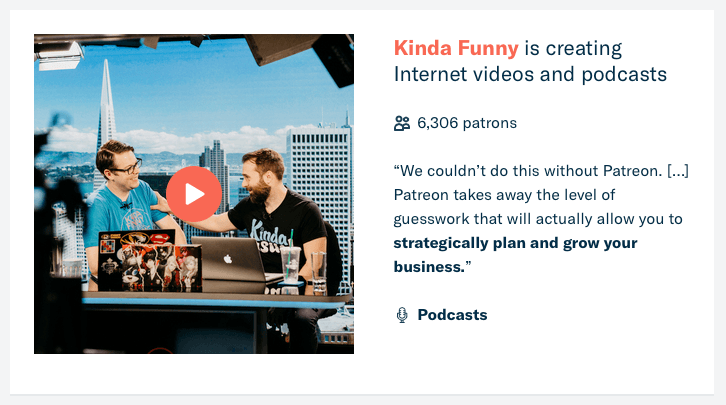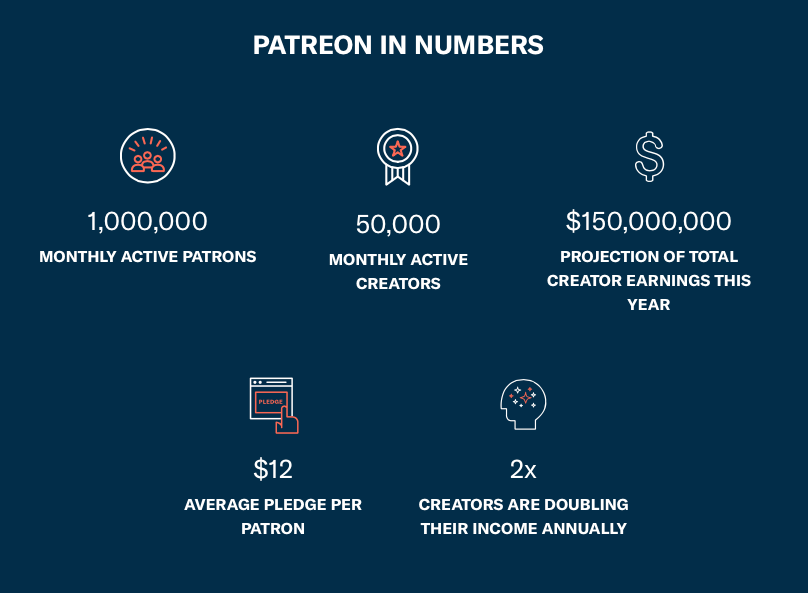Patreon: Modernizing and crowdsourcing patronage of the arts

Patreon allows creators of all stripes to crowdsource funding on a subscription basis.
TL;DR:
- Patreon (pronounced “patron”) is a crowdfunding platform that connects subscribers with creators on a subscription basis – rather than an episodic one
- They make money by taking a 5% fee from each pledge
- The company has attracted 107MM total dollars in VC funding over 4 rounds
- Currently, it has connected >50,000 content creators with >1MM subscribers, and created >$100MM of total net income for creators
- A recent attempt to increase fees shifted the burden of fees to pledges, causing loss of low-dollar subscribers and threatened to dissolve the crowds that the platform had built for creators
- Patreon quickly undid the rate hike, but learned how crowds can be aggregated, and how valuable they can be
WHAT IS IT?
Patreon (pronounced “patron”) is a crowdfunding platform company that connects content creators with crowds of subscribers.
It is a modern spin on the ancient concept of “patronage.” Patrons would pay artists to support their creative efforts. This model is perhaps most associated with the Renaissance of 14th-17th century Europe, in which wealthy aristocrats paid artists – such as Leonardo Da Vinci, William Shakespeare, and Mozart – both to enjoy the works of art and the prestige associated with being a patron of the arts. Both these allures have persisted to the modern day.
Patreon has adapted this for the internet and created a platform to allow the masses to become patrons of art, facilitating creation of diverse, original works that may not otherwise have been created [1].
Creators on Patreon come in all forms, including podcasters, YouTubers, musicians, writers, visual artists, and more.
Patreon helps creators connect with a crowd of supporters and build a fan base. The platform employs a tiered monthly subscription where patrons can support a creator at a variety of monetary levels, each pegged to a proportionate level of benefits. For example, a subscription of $1 per month may grant the subscriber access to general content. $5 may grant early access. $10 may unlock additional content. $15 may include merchandise. Creators can set any level and type of benefit structure that fits their content. They can also make some content free to the public to attract new subscribers.
LEVERAGING CROWDS
Through the mechanisms above, Patreon can help creators generate a continuing income stream while maintaining full creative control. More importantly, Patreon creates a channel for direct communication between the creators and their patrons. The platform allows subscribers to comment on the elements of creation they like or dislike, provide ideas for new content, or even collaborate on future content. This can create a virtuous cycle. As patrons feel more invested and connected to the artists, they feel more motivated to increase the level of their subscription.
Network Effects
Subscribers can discuss with each other directly on Patreon or through chat communities set up by the creators on Patreon.
Similarly, creators can also connect and support each other’s efforts, sharing resources, tips, and tools. In this way, Patreon leverages same-side network effects on both sides of their platform. Indeed, a vast number of YouTube videos and online posts have emerged as creators share tips and strategies for increasing growth [2].
Patreon has organized some of the supporting activities in blog form on its website [3], and in the form of support tools [4]. As the size of the creator community grows, Patreon can attract more benefits for the creators from 3rd parties, building a richer and more diverse “portfolio of tools” [5]. These include both the tools to support content creation (e.g. StreamLabs) as well as tools to support the creator’s businesses (e.g. Wealthfront, Weebly). Again, same side network effects increase the value of the platform [6].
SHOW ME THE MONEY
With regards to financial value creation and capture, Patreon takes 5% of each pledge as its commission. Another 2-10% of each pledge gets consumed by payment-processing fees to third-parties, leaving 85%-93% of each pledge for the creator.
This business model lets creators get paid directly by those who enjoy their creations. This is different from traditional models using corporate sponsors or advertisers that may be predatory and reward creators poorly [7].
Take the example of Jack Conte, a musician who founded Patreon. Over 3 months, he spent $10,000 creating a music video (titled “Pedals,” see below) that generated 2 million views but only $936 in advertising revenue on YouTube [8]. Conte argues that this model devalues creation, and incentivizes pursuit of clicks and views rather than focus on quality content [9]. Patreon’s model provides predictable and continuous income to artists allowing them to focus on their craft.
Patreon’s business model seems to have worked. Even with a small pledge of $5 per month per subscriber, the creator may earn a lot many times more than they would have from ad revenue for the same output [10]. Given the average payment on Patreon is $12, the advantages over ad revenue can be large [11].
The results are impressive. Over $100MM has been paid to creators since the Patreon’s launch in 2013, and the earnings, number of creators, and number of patrons all continue to grow. Meanwhile, the site’s Alexa rank has risen to 403 globally and 195 in the US [12].
Not all are as bullish. One critique of Patreon notes that while some creators may make significant earnings, many others make very little [13].
Others say this critique misses the point. Art creation is inherently difficult and it is up to creators to attract fans who are willing to pledge. What matters is that most dollars pledged go to the creators as opposed to third parties. It is by this novel metric that Patreon performs beautifully [14].
Investors seem enthusiastic. Patreon has raised $107MM over 4 rounds of funding, yielding a valuation of $400-450MM [15, 16].
RATE HIKE REVEALS IMPORTANCE OF CROWDS
As discussed previously, Patreon originally took a 5% fee from each pledge, and then charged a transaction fee that varied with the creator’s chosen pay schedule for third-party payment processing. Over time, creators complained. The fees were too high and they weren’t seeing enough of a share of the pledges.
In response to these complaints, and declaring a “creator first” mindset, Patreon created a new schedule that would maintain the 5% fee to Patreon and pass on 95% to the creator. The patrons, however, would now be charged an additional fee of $ 0.35 plus 2.9% of the pledge [17].
The new fee was not received well. It was too burdensome on low-dollar subscribers – it effectively increased the cost of a $1 pledge by 37.9%. This led to major reductions in low-dollar subscribers, wiping out large swathes of fans [18].
The outcry attracted vast attention in tech-focused and general news outlets [19-28].
The intense backlash from a simple fee change reveals what makes crowds so powerful. Crowds may be at their best when they have low activation energy – or low barriers to joining – for each member of the crowd. That core phenomenon facilitates the aggregation of large bodies of individuals that together can offer great value. For creators on Patreon, that value came in the form of financial reimbursement, feedback on content creation (their core function), and personal satisfaction from engagement with the end-consumers of their content. By introducing this fee, Patreon inserted themselves into the all-important relationship between creator and patron, between crowd-leverager and crowd.
Patreon quickly recognized their misstep. Within a week, they withdrew the fee change. They apologized and explained why, and committed to working with creators to address the issues in the existing fee model [29].
FUTURE
Patreon’s success in value creation has been impressive. As noted in Forbes, they have worked the magic of designing a system where creativity is paid for in an era when content of these forms is largely free [30].
Moving forward, it will be interesting to see whether Patreon’s model is sustainable, and where the ceiling for value creation lies – if it exists at all. Danny Rimer of Index Ventures and former Etsy board member thinks, “Patreon has a very good chance of being fundamental to the fabric and structure of the internet” [7].
Maybe. It’s still early days. Time will tell.
REFERENCES
- “What Is Patreon?” YouTube, YouTube, 14 June 2017, www.youtube.com/watch?time_continue=15&v=rwvUjAv6pxg.
- “What to Know Before Starting Patreon.” YouTube, YouTube, 7 Feb. 2018, www.youtube.com/watch?v=34ltAowKUvU.
- “Home.” The Patreon Blog, blog.patreon.com/.
- Arnold, Taryn. “Patreon’s New Features: Tools to Run Your Membership Business.” The Patreon Blog, Patreon, 15 June 2017, blog.patreon.com/new-membership-features/.
- McCracken, Harry. “Patreon Wants to Help Creators Turn Fan Followings into Media Companies.” Fast Company, Fast Company, 14 June 2017, www.fastcompany.com/4040723/patreon-wants-to-help-creators-turn-fan-followings-into-media-companies.
- “Resources and Products to Help You Do More with Patreon.” Patreon Partner Services Directory, Patreon, partners.patreon.com/.
- Vynck, Gerrit De. “Patreon Found a Way to Pay the Creative Class. Will It Work?” com, Bloomberg, 17 Jan. 2018, www.bloomberg.com/news/articles/2018-01-17/patreon-found-a-way-to-pay-the-creative-class-will-it-work.
- “Pedals Music Video (Featuring REAL Robots) – Conte.” YouTube, YouTube, 7 May 2013, www.youtube.com/watch?v=mZ02alEkbLw&feature=youtu.be.
- Conte, Jack. “Creators Have Made $100M on Patreon.” Art/Work -behind the Scenes at Patreon, Patreon. 9 Jan. 2017, patreonhq.com/creators-have-made-100m-on-patreon-ddfcc9338662.
- C, Maura. “What Patreon’s Growth Says about the Future for Creators.” Art/Work -behind the Scenes at Patreon, Patreon, 18 May 2017, patreonhq.com/what-patreons-growth-says-about-the-future-for-creators-9e3cc5e434dc.
- Roettgers, Janko. “Patreon Raises $60 Million Series C for Creator-Led Subscription Services.” Variety, Variety Media, LLC, 19 Sept. 2017, variety.com/2017/digital/news/patreon-60-million-series-c-1202563002/.
- “Patreon.com Traffic Statistics.” com, Alexa, www.alexa.com/siteinfo/patreon.com.
- Knepper, Brent. “No One Makes a Living on Patreon.” The Outline, The Outline, 7 Dec. 2017, theoutline.com/post/2571/no-one-makes-a-living-on-patreon?zd=1&zi=c2pywzbk.
- Doctorow, Cory. “The Point of Patreon Isn’t How Many People Earn a Full-Time Living, It’s How Much of the Money from Art Goes to Artists.” Boing Boing, 8 Dec. 2017, boingboing.net/2017/12/08/measuring-the-right-thing.html.
- “Patreon.” Crunchbase, www.crunchbase.com/organization/patreon.
- Morris, David Z. “Patreon’s Fee Change Stokes the Ire of Creators.” Fortune, Time Inc., 9 Dec. 2017, fortune.com/2017/12/09/patreon-fee-changes/.
- “We’re Updating Patreon’s Fee Structure. Here’s Why.” The Patreon Blog, Patreon, 6 Dec. 2017, blog.patreon.com/updating-patreons-fee-structure/.
- Ohlheiser, Abby. “Facing a Rebellion of Furious Creators, Patreon Backs Away from a New Fee.” The Washington Post, WP Company, 13 Dec. 2017, www.washingtonpost.com/news/the-intersect/wp/2017/12/13/facing-a-rebellion-of-furious-creators-patreon-backs-away-from-a-new-fee/?utm_term=.7181bb70169d.
- Constine, Josh. “Why Content Crowdfunder Patreon Is Halting Its Hated Fee Change.” TechCrunch, TechCrunch, 14 Dec. 2017, techcrunch.com/2017/12/13/patreon-fee-change/.
- Robertson, Adi. “Patreon Scraps New Service Fee and Apologizes to Users.” The Verge, The Verge, 13 Dec. 2017, www.theverge.com/2017/12/13/16772556/patreon-drops-service-fee-plan-apology-update.
- Krishna, Swapna. “Patreon’s Fee Change Punishes Supporters Who Make Small Pledges.” Engadget, 8 Dec. 2017, www.engadget.com/2017/12/08/patreon-fee-change-will-hurt-small-contributions/.
- Alexander, Julia. “Patreon Changes Have Creators Concerned They’ll Lose Income, Supporters (Update).” Polygon, Polygon, 7 Dec. 2017, www.polygon.com/2017/12/7/16747346/patreon-service-fee-pledge-creators.
- Alexander, Julia. “Patreon Backtracks on Service Fee after Community Uproar.” Polygon, Polygon, 13 Dec. 2017, www.polygon.com/2017/12/13/16773142/patreon-service-fee-community-backlash.
- Hughes, William. “Patreon Abandons Controversial Plan to Change Its Fee Structure.” The A.V. Club, Www.avclub.com, 14 Dec. 2017, www.avclub.com/patreon-abandons-controversial-plan-to-change-its-fee-s-1821279535.
- Lekach, Sasha. “Patreon Might Destroy Itself While Trying to Figure out How to Pay Artists Online.” Mashable, Mashable, 13 Dec. 2017, mashable.com/2017/12/13/patreon-fee-structure-change/#sg.IokH7VPqm.
- Domonoske, Camila. “After Outcry, Crowdfunding Site Patreon Backs Off Plan To Raise Fees.” NPR, NPR, 13 Dec. 2017, www.npr.org/sections/thetwo-way/2017/12/13/570549063/after-outcry-crowdfunding-site-patreon-backs-off-plan-to-raise-fees.
- Picchi, Aimee. “Patreon Angers Artists, Content Creators with New Fee.” CBS News, CBS Interactive, 11 Dec. 2017, cbsnews.com/news/patreon-angers-artists-content-creators-with-new-fee/.
- Cole, Samantha. “Creators Are Concerned About Patreon’s Service Fee Change.” Motherboard, 7 Dec. 2017, motherboard.vice.com/en_us/article/qvzb7v/creators-are-concerned-about-patreon-service-fee-change.
- Conte, Jack. “We Messed up. We’re Sorry, and We’re Not Rolling out the Fees Change.” The Patreon Blog, 13 Dec. 2017, blog.patreon.com/not-rolling-out-fees-change/.
- McIntyre, Hugh. “Patreon Is On Track To Pay Creators $150 Million In 2017 Alone.” Forbes, Forbes Magazine, 18 May 2017, www.forbes.com/sites/hughmcintyre/2017/05/18/patreon-is-on-track-to-pay-creators-150-million-in-2017-alone/#7f9d907960b7.













